Slick Willie 2 Disclaimer & Instructions
 Remember: The information contained herein is, to the best of our knowledge and belief, accurate. However, since handling conditions and use are beyond our control, we make no guarantee of results, and assume no liability for damages incurred by use of this material.
Remember: The information contained herein is, to the best of our knowledge and belief, accurate. However, since handling conditions and use are beyond our control, we make no guarantee of results, and assume no liability for damages incurred by use of this material.
Concrete Pump Supply LLC responsibility for any claim arising out of breach of warranty, negligence, and strict liability or other¬wise is limited to the purchase price of the materials.
Instructions:
Step 1. Mix:
• Empty one bag into five-gallon bucket and half fill with water.¹
• Stir for one minute.
• Fill remainder of bucket with water.
• Stir for one minute.
• Let mix stand for at least 5 minutes or until a slick-like texture develops.
Step 2. Prime Pump²: (determine situation that best describes your pump)
• If the pump has a priming port (CAPS), pour into primer port just ahead of ready-mix.
If primed through the hopper:
For vertical intake ports (gate or rock valve):
• Fill water in hopper high enough for intake parts to charge as pump cycles.
• Pour the mixed Slick-Willie2: New and Improved into hopper so the prime is charged in the system ahead of the ready-mix
For horizontal intake ports (ball or flapper valve):
• Fill water in hopper as necessary in order to allow the port or ports to charge as pump cycles.
• Pour the mixed Slick-Willie2: New and Improved directly into intake port just ahead of the ready-mix.
If primed directly in the hopper:
• Pour at least 5 gallons of water into hopper.
• Pour one bag of Slick-Willie2: New and Improved primer into hopper and cycle pump in revers for 15 to 20 strokes.
• Let stand at least 10 minutes prior to priming system.
• Charge prime into system ahead of ready-mix.
How much to use? One bag (1/4 pound) for each 150 feet of 5” system³.
Best results: Pre-mix in a 5-gallon pail the night before.
¹ Slick-Willie2 provides lubrication for pipe and hose. The responsibility to provide a safe workplace remains with the user. Each user should consider the health hazards and safety information contained herein as a guide and should take any pre-caution necessary to ensure a safe work environment.
² More water and primer may be needed in cases where the hopper is extraordinarily large or the intake valve is placed high up on the hop- per. In all cases, primer should be completely charged into system ahead of ready-mix.
³ Horizontal pumping jobs may require more priming agent. A sponge may be placed ahead of the mixture to insure that system interior is completely coated.
